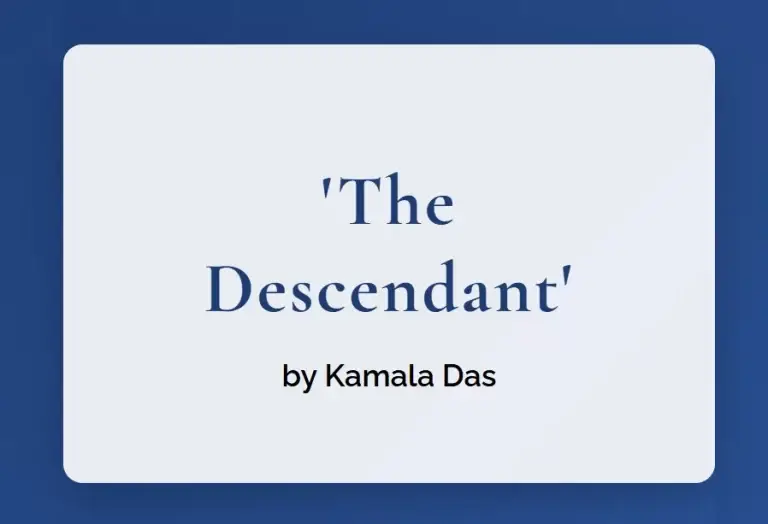“The Descendant” stands as one of Kamala Das’s most evocative explorations of generational inheritance and cultural memory. Through the intimate lens of a grandmother’s house, the poem weaves together themes of ancestral legacy, feminine identity, and the preservation of memory in an increasingly modernized world.
Table of Contents
The Architecture of Memory
The poem opens with powerfully atmospheric lines:
“My grandmother’s house has a room
Dark as a cave, lit by three glass cages
Where kerosene lamps burn.”
This careful construction of space serves multiple purposes. The darkness represents both the mystery of the past and the shadowed corners of family history, while the kerosene lamps suggest the fragile persistence of memory. The “glass cages” create a museum-like quality, suggesting both preservation and separation from the past.
Sensory Landscapes and Memory
Kamala Das masterfully employs sensory details to create a rich tapestry of remembrance:
“The room smells of old photographs,
Yellow with age, and cursive letters In faded ink on inland papers”
These lines demonstrate how memory operates through multiple senses – not just the visual preservation of photographs, but the olfactory traces that trigger remembrance. The yellowing of photographs and fading of ink serve as metaphors for the gradual erosion of memory and the passage of time.
The Female Lineage
Central to the poem’s exploration is the matrilineal connection between grandmother and granddaughter. This relationship serves as a lens through which Kamala Das examines:
Inheritance and Identity
- The transmission of cultural knowledge between generations
- The complex inheritance of feminine identity in Indian society
- The tension between traditional roles and modern selfhood
- The weight of expectations passed down through female lineage
Physical and Emotional Spaces
- The grandmother’s house as a repository of memory
- Domestic spaces as archives of family history
- The intersection of personal and collective memory
- The role of physical objects in preserving emotional connections
Technical Mastery
Kamala Das demonstrates remarkable technical skill throughout the poem:
Structural Elements
- Free verse that mirrors the fluid nature of memory
- Strategic use of enjambment to create momentum
- Careful balance between concrete detail and abstract reflection
- Rhythmic patterns that echo the act of remembering
Imagery and Symbolism
- Kerosene lamps as beacons of preserved wisdom
- The dark room as a metaphor for the past’s mysteries
- Photographs and letters as tangible links to history
- The house itself as a symbol of cultural continuity
Cultural Context and Significance
The poem operates within several important contexts:
Postcolonial Identity
- Navigation between traditional Indian values and modern influences
- The preservation of cultural memory in a rapidly changing society
- The role of domestic spaces in maintaining cultural continuity
- The impact of modernization on traditional family structures
Feminist Perspectives
- The importance of female-centered narratives in Indian literature
- The role of women in preserving family and cultural history
- The complexity of feminine identity across generations
- The grandmother figure as both preserver and transmitter of culture
Contemporary Relevance
“The Descendant” remains powerfully relevant today, addressing:
- The universal experience of generational distance and connection
- The challenge of maintaining cultural identity in a globalized world
- The role of physical spaces and objects in preserving memory
- The importance of intergenerational relationships in identity formation
The Art of Preservation
Kamala Das’s poem ultimately speaks to the delicate balance between preservation and progress. Through its careful attention to detail and emotional resonance, it explores how we maintain connections to our past while moving forward into the future. The poem suggests that true preservation requires active engagement with memory – not just the physical artifacts of photographs and letters, but the living transmission of experience and understanding between generations.
Conclusion: Memory as Living Heritage
“The Descendant” masterfully captures the complexity of generational inheritance, particularly within the context of Indian femininity and family tradition. Through its careful attention to sensory detail and emotional resonance, the poem creates a powerful meditation on memory, identity, and the bonds between generations. It reminds us that our connection to the past is not just through physical artifacts but through the living chain of memory and understanding that passes from one generation to the next.
The poem’s exploration of how we inherit and interpret our ancestral past speaks to contemporary concerns about cultural preservation and identity formation in an increasingly globalized world. It suggests that true heritage lies not just in the preservation of physical spaces and objects, but in the active engagement with and interpretation of the past by each new generation.



1 Comment
Pingback: The Old Playhouse: Kamala Das's Powerful Metaphor for Marital Confinement - LitGram by MukeshRishit